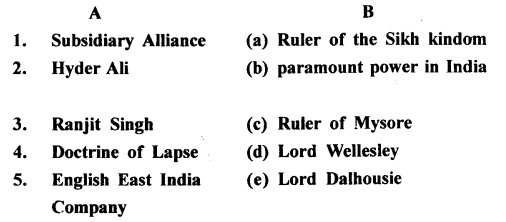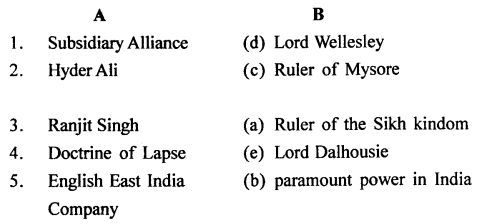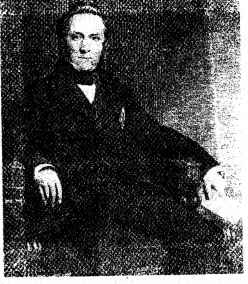The Trail History and Civics for Class 8 ICSE Solutions – British Policies and Their Impacts
ICSE SolutionsSelina ICSE SolutionsML Aggarwal Solutions
The Trail History and Civics for Class 8 ICSE Answers
Trail HistoryCivics Focus on HistoryCivics GeographyBiologyChemistryPhysicsMaths
EXERCISES
A. Fill in the blanks:
- The Bengal famine of 1770 was one of the most terrible famines in human history.
- A large share of revenue collected by the Company in India had to be paid to the British government as home charges.
- Under the Mahalwari system the revenue settlement was made with the village as a whole.
- To eliminate competition from India’s traditional industries the British transformed India into a supplier of raw material and a market for british products.
- Before the advent of the British the Indian craftspeople operated at two levels—the rural and the urban levels.
- Before the advent of the British the Indian textile industry was the finest and the largest in the world.
- After the Battle of Plassey the Company used its political power to destroy the Indian handicraft industry and promote British industries.
- With the spread of the Industrial Revolution in England, Indian markets were flooded with cheap, machine made textiles of British mills.
- By 1850, India became a major importer of english textiles.
- Lord Dalhousie introduced the railway system in India in 1853.
- The Grand Trunk Road from Calcutta to Peshawar was reconstructed by the British in the 19th century.
B. Match the following:

Answer:
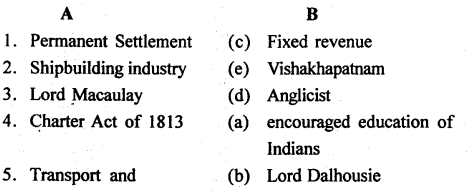
communication
development
C. Choose the correct answer:
1. The Treaty of Allahabad/Madras/Benaras granted the English East India Company the right to collect revenue from Bihar, Bengal and Orissa.
Ans. The Treaty of Allahabad granted the English East India Company the right to collect revenue from Bihar, Bengal and Orissa.
2.To remove the defect of the revenue system Lord Cornwallis introduced the Permanent settlement/Ryotwari system/ Mahalwari system in 1793.
Ans. To remove the defect of the revenue system Lord Cornwallis introduced the Permanent settlement in 1793.
3. The Ryotwari system of revenue collection was introduced in Madras/Calcutta/Bombay presidency.
Ans. The Ryotwari system of revenue collection was introduced in Madras presidency.
4. The Charter Act of 1813, directed the Company to spend 1/ 10/15 lakh rupees on the education of Indians.
Ans. The Charter Act of 1813, directed the Company to spend 1 lakh rupees on the education of Indians.
5. The first railway line was from Bombay to Poona/Thana/ Calcutta.
Ans. The first railway line was from Bombay to Thana.
D. State whether the following are true or false:
- Before the advent of the British more than 95 per cent of Indians lived in villages.
True. - The Indian peasants were satisfied with the Company’s revenue collection methods.
False. - The Permanent Settlement assured the Company a fixed revenue at a fixed time even during natural calamities.
True. - Lord Macaulay insisted that Western education should be imparted through the medium of vernacular languages.
False.
Correct: Lord Macaulay insisted that Western education should be imparted through the medium of the English. - The development of transport and communication systems did not benefit Indians in any way.
False.
Correct : The development of transport and communication systems benefit Indians in unexpected ways.
E. Answer the following questions in one or two words/ sentences:
Question 1.
Why did the Indian peasants begin to grow cash crops ?
Answer:
Since revenue payments had to be paid in cash, the peasants began to grow cash crops like jute, cotton, sugarcane etc., which could be sold for ready cash in the markets.
Question 2.
How did the Company utilize the revenues from Bengal ?
Answer:
The revenue from Bengal was used to cover as salaries of officials and to finance the trading activities of the company. Raw materials for England’s growing industries were bought with the revenues collected from Bengal.
Question 3.
What were the drawbacks of Warren Hastings’s five-year revenue settlement ?
Answer:
The new zamindars, unsure of retaining the contract at the next auction, had no permanent interest in the land and did nothing to improve it. The peasants were fleeced to meet the revenue targets.
Question 4.
What was the significance of the Charter Act of 1813 in the context of British educational policy in India?
Answer:
The Charter Act of 1813 directed the Company to spend 1 lakh rupees on the education of Indians. This was the first step taken by the British rulers towards the encouragement of the study of literature and science in India. The Charter Act, however, did not lay down any specific guidelines.
Question 5.
In what way would westernized Indians help to promote the interests of British manufacturers?
Answer:
- The British system of education produced English-speaking Indian graduates who helped their British masters to run the empire.
- It also created a class of Indians who were Westernized to the extent that they rejected Indian culture and patronized anything and everything that was British including British goods.
Question 6.
How did knowledge of contemporary nationalist movements in Europe inspire the Indians?
Answer:
Knowledge of contemporary nationalist movements in Europe fired the Indians with an intense desire to build a new India progressive, strong, prosperous and united.
Question 7.
Mention any two positive effects of the introduction of English in the Indian educational system.
Answer:
Western education, however, impacted Indian society in a way the British could never have imagined.
- It aroused in them an awareness of the evil effects of foreign rule.
- The teachings of modem European philosophers instilled in them an admiration for democratic institutions.
Question 8.
Which section of Indians gained from the British commercial policies ?
Answer:
Indian Steel, Urban Centers specialized in gold and silver ornaments, cooper, brass ware, and crafts people.
Question 9.
How would the improved transport and communication system benefit the Indian later ?
Answer:
The transport and communication system, however, would ultimately benefit Indians in unexpected ways. Besides stimulating trade and commerce it would bring the people of India closer to one another and infuse in them a sense of unity and nationalism—a development that would have far-reaching effects on India’s future.
F. Answer the following questions briefly:
Question 1.
In the context of Permanent Settlement of Bengal answer the following:
(a) Explain the special features of the Permanent Settlement
(b) What are its advantages ?
(c) Briefly describe its disavantages
Answer:
(a) The system had two special features:
Permanent ownership of land
- The zamindars, collectors of land revenue, were made permanent legal owners of the land from which they collected the land tax. The tax collector became the landlord.
- The zamindar’s ownership rights became hereditary and he was given the freedom to sell or mortgage his land.
- The cultivators of the land became the tenants of the zamindar and lost their ancestral rights. They had to pay a rent to the zamindar who could increase the rent as and when they wanted to.
Fixed Revenue
- The land revenue was fixed on a permanent basis. The Company could not make any further demands on the zamindars.
- The zamindar had to pay the land revenue once a year on a specific date. If he failed to pay on time, his lands were confiscated and sold.
(b) Advantages
- The Company was assured of a fixed revenue at a fixed time even during natural calamities.
- The collection of revenue was simpler and cheaper. The zamindars replaced hundreds of paid tax officials.
- The British won the support and loyalty of the powerful and priviledged class of zamindars that they had created.
- As permanent owners of the lands, the zamindars took several steps to increase agricultural production whose benefits they would enjoy.
(c) Disadvantages
- The cultivators were left at the mercy of the zamindar, who exploited and oppressed them, increased their rents and evicted them from the land when they unable to pay the high rents. This led to widespread poverty and misery of the cultivators.
- Since the revenue was fixed, the government would not get a share of increasing returns form the land.
- This system gave rise to a class of absentee landlords. These zamindars preferred to live in cities and towns and sublet then- land to tenants at high rates. These tenants in turn sublet it to other tenants. As this process continued, the rent rates increased with each successive layer. The entire burden of paying the enhanced rates had to be borne by the actual cultivator—the last tenant.
Question 2.
With reference to Ryotwari and Mahalwari systems answer the following:
(a) Explain the features of the Ryotwari system.
(b) What were the features of the Ryotwari system.
(c) What were the fundamental changes introduced by these systems in the traditional land system of the country ?
Answer:
(a)
The features of Ryotwari system were:
- The cultivator (ryot) was recognized as the owner of his land as long as he paid the land revenue.
- The revenue was paid directly by the cultivator to the revenue officials.
- The revenue was fixed for 30 years after which it could be revised.
- Collection of revenue was rigid. There was no remission of revenue even when the crops failed.
(b)
‘Mahal’ means a group of villages. Under this system land was collectively owned by the villagers. The revenue settlement was made with the village as a whole. The talukdar or head of the mahal collected the revenue and handed it over to the British collectors.
(c)
The Zamindari and Ryotwari systems introduced fundamental changes in the traditional land systems of the country. Land became a commodity — a new form of property — which could be bought, sold and mortgaged as and when the need arose. The stability and continuity of the Indian villages were shaken and the traditional structure of rural society began to disintegrate.
Question 3.
The first century of British rule resulted in the decay and destruction of traditional India trade and industry. Explain this statement with reference to the following:
(a) Political powers of the Company
(b) Collapse of ruling dynasties and ruling courts
(c) Decline of modern India industries.
Answer:
(a)
After the Battle of Plassey in 1757, the company used its political power to destroy the Indian handicraft industry and promote British industries. The Indian weavers were forced to sell their products to the Company at very low prices. To add to their miseries, they were compelled to buy interior raw cotton at high prices from the Company officials who bought it from the Indian farmers at low rates.
(b)
With the establishment and expansion of the British empire in India, the royal courts and the nobility of the ruling dynasties, (including the Mughals) collapsed one by one. The craftspersons and artisans were deprived of royal patronage and Indian handicrafts suffered a severe setback.
(c)
The British government also obstructed the growth of modem Indian industries to keep the country underdeveloped and economically backward. Almost everything of daily use like needles, pins, sewing machines, thread, soaps, biscuits, cycles, medicines, paper, etc. were imported from England.
Question 4.
The Charter Act of 1813 passed by the British Parliament was the first major step to introduce changes in the Indian system of education. In this context discuss:
(a) The general directives issued to the Company in the Charter Act of 1813 and its inherent weakness
(b) The Great Debate over the content and medium of education
(c) The introduction and spread of Western education
Answer:
(a)
The Charter Act of 1813 directed the Company to spend 1 lakh rupees on the education of Indians. This was the first step taken by the British rulers towards the encouragement of the study of literature and science in India. The Charter Act, however, did not lay down any specific guidelines. The money sanctioned for the education project lay untouched for 2 decades while a great controversy raged over the content and medium of education.
(b)
One group favoured the promotion of traditional Indian learning through the medium of classical (Sanskrit and Persian) and regional language. This group was known as the Orientalists. The other group led by Lord Macaulay (Law Member of the Governor General’s Council) insisted that Western education should be introduced and imparted.
(c)
The government began to set up English medium schools and colleges for the education of a limited number of Indians. In 1844, English became the official language and the government announced that Indians educated in British schools would be given jobs in government services. This helped the spread of English education in India.
Question 5.
The Wood’s Despatch introduced further changes in the Indian educational system. With reference to the above statement, answer the following questions:
(a) What was the purpose behind the introduction of Western education in India?
(b) How did the introduction of Western education benefit the British?
(c) Explain how (1) Western education and (2) the English language led to the rise of a spirit of nationalism among the Indians.
Answer:
(a) The purpose behind the introduction of Western education in India.
- The primary motive of the British government was to create a class of persons, Indian in blood and colour, but British in taste, opinions, morals and intellect. The class of Indians could be employed, on low salaries, as clerks in the Civil Service.
- This would greatly reduce the heavy expenditure involved in running the administration. Employing the
British in these posts was very expensive and difficult. - Westernized Indians, it was hoped, would create a demand for British goods and promote the interests of British manufacturers.
- Western education would inculcate in the Indians a sense of admiration and respect for British rule. This would strengthen the foundations of the British empire in India.
(b) The introduction and spread of Western education in India benefited the British like:
- The British system of education produced English speaking Indian graduates who helped their British masters to run the empire.
- It also created a class of Indians who were Westernized to the extent that they rejected Indian culture and patronized anything and everything that was British including British goods.
(c) Western education, however, impacted Indian society in a way the British could never have imagined.
- It aroused in them an awareness of the evil effects of foreign rule.
- The teachings of modern European philosophers instilled in them an admiration for democratic institutions.
Question 6.
With reference to the transport and communication system in India, answer the following questions:
(a) Why and how did the British develop proper transport and communication facilities in India?
(b) How did the railways serve the interests of the British?
(c) Explain how the improved transport and communication system proved beneficial for Indians.
Answer:
(a)
The transport and communication system in India in the 18th century was very backward. The British realized the importance of developing proper
(b)
The railways ensured quick transfer of troops and ammunition during revolts and other disturbances and the easy transportation of raw materials and manufactured goods.
(c)
The transport and communication system, however, would ultimately benefit Indians in unexpected ways. Besides stimulating trade and commerce it would bring the people of India closer to one another and infuse in them a sense of unity and nationalism. A development that would have far-reaching effects on India’s independence
The improved communication system established by the British benefited the Indians in unexpected ways. Besides stimulating trade and commerce it brought the people of India closer to one another and infused in them a sense of unity and nationalism which had far-reaching effects on Indian’s future.
G Picture Study:
This is the picture of an Indian nationalist.
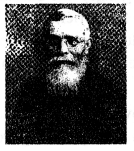
1. Identify the person.
Ans. Dadabhai Naoroji.
2. What did he think about the British rule in India ?
Ans. Dadabhai Naoroji one of the early nationalist of India, described British rule as an ‘everlasting….foreign invasion that was utterly though gradually destroying the country’.
3. Explain any three ways in which he felt that the Indian economy was being exploited by the British.
Ans.
- A greater part of the salaries of British officials and employees of the Company (paid out of Indian revenues) was deposited in England as savings.
- Material resources like cotton, jute, indigo, tea, coffee, etc. were transported to England.
- Goods purchased in India with revenues drawn from the country were sent to England.
- Huge sums of money which the officials received as bribes and gifts were sent out of the country.
OTHER IMPORTANT QUESTIONS
Question 1.
When the Charter Act of 1813 was passed a great controversy arose on the issue of education.
(1) What was the controversy about?
(2) How was it resolved?
Answer:
- The controversy was that one group favoured the promotion of traditional Indian learning through the medium of classical and regional languages like Sanskrit and Persian. This group was known as the Orientalists. The other group insisted that Western education should be introduced and imparted through the medium of English. This group was called Anglicists.
- In 1835 the government passed a resolution outlining its New Eduaction Policy. The government would utilize its educational funds on teaching Western science and literature through the medium of the English language.
Question 2.
The impact of Western ideas and education gave birth to a new awakening. Explain.
Answer:
The Impact of Western ideas and education gave birth to a new awakening like:
- It aroused in them an awareness of the evil effects of foreign rule.
- The teachings of modem European philosophers instilled in them an admiration for democratic institutions.
- Knowledge of contemporary nationalist movements in Europe fired the Indians with an intense desire to build a new India progressive, strong, prosperous and united
